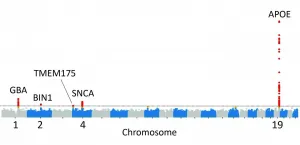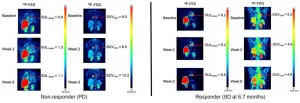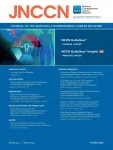(Press-News.org) In a study led by National Institutes of Health (NIH) researchers, scientists found that five genes may play a critical role in determining whether a person will suffer from Lewy body dementia, a devastating disorder that riddles the brain with clumps of abnormal protein deposits called Lewy bodies. Lewy bodies are also a hallmark of Parkinson's disease. The results, published in Nature Genetics, not only supported the disease's ties to Parkinson's disease but also suggested that people who have Lewy body dementia may share similar genetic profiles to those who have Alzheimer's disease.
"Lewy body dementia is a devastating brain disorder for which we have no effective treatments. Patients often appear to suffer the worst of both Alzheimer's and Parkinson's diseases. Our results support the idea that this may be because Lewy body dementia is caused by a spectrum of problems that can be seen in both disorders," said Sonja Scholz, M.D., Ph.D., investigator at the NIH's National Institute of Neurological Disorders and Stroke (NINDS) and the senior author of the study. "We hope that these results will act as a blueprint for understanding the disease and developing new treatments."
The study was led by Dr. Scholz's team and researchers in the lab of Bryan J. Traynor, M.D., Ph.D., senior investigator at the NIH's National Institute on Aging (NIA).
Lewy body dementia usually affects people over 65 years old. Early signs of the disease include hallucinations, mood swings, and problems with thinking, movements, and sleep. Patients who initially have cognitive and behavioral problems are usually diagnosed as having dementia with Lewy bodies, but are sometimes mistakenly diagnosed with Alzheimer's disease. Alternatively, many patients, that are initially diagnosed with Parkinson's disease, may eventually have difficulties with thinking and mood caused by Lewy body dementia. In both cases, as the disease worsens, patients become severely disabled and may die within 8 years of diagnosis.
A growing body of evidence suggests genetics may play a role in the disorder and that some cases may be inherited. Scientists have found that some of these rare cases can be caused by mutations in the gene for alpha-synuclein (SNCA), the main protein found in Lewy bodies. Further studies have found that variants in the gene for apolipoprotein E (APOE), which is known to play a role in Alzheimer's disease, may also play one in Lewy body dementia.
"Compared to other neurodegenerative disorders, very little is known about the genetic forces behind Lewy body dementia," said Dr. Traynor. "To get a better understanding we wanted to study the genetic architecture of Lewy body dementia."
To do this, they compared the chromosomal DNA sequences of 2,981 Lewy body dementia patients with those of 4,931 healthy, age-matched control participants. Samples were collected from participants of European ancestry at 44 sites: 17 in Europe and 27 across North America. The DNA sequencing was led by Clifton Dalgard, Ph.D., and researchers at The American Genome Center, a series of state-of-the-art laboratories at the Uniformed Services University of the Health Sciences and supported by the Henry M. Jackson Foundation for the Advancement of Military Medicine.
Initially, they found that the sequences of five genes from the Lewy body dementia patients were often different from those of the controls, suggesting that these genes may be important. It was the first time that two of the genes, called BIN1 and TMEM175, had been implicated in the disease. These genes may also have ties to Alzheimer's and Parkinson's diseases. The other three genes, SNCA, APOE, and GBA, had been implicated in previous studies, and thus, strengthened the importance of the genes in Lewy body dementia.
The researchers also saw differences in the same five genes when they compared the DNA sequences of another 970 Lewy body dementia patients with a new set of 8,928 control subjects, confirming their initial results.
Further analysis suggested that changes in the activity of these genes may lead to dementia and that the GBA gene may have a particularly strong influence on the disease. The gene encodes instructions for beta-glucosylceramidase, a protein that helps a cell's recycling system break down sugary fats. The researchers found that both common and rare variants in the GBA gene are tied to Lewy body dementia.
"These results provide a list of five genes that we strongly suspect play a role in Lewy body dementia," said Dr. Traynor.
Finally, to examine the apparent links between Lewy body dementia and other neurodegenerative diseases, the researchers further analyzed data from previous studies on Alzheimer's and Parkinson's disease. They found that the genetic profiles of the patients in this study had higher chances of suffering from either Alzheimer's or Parkinson's disease than the age-matched control subjects. These predictions held even after they lowered the potential impact of known Alzheimer's and Parkinson's disease-causing genes, like APOE and SNCA. Interestingly, the patient's genetic risk profiles for Alzheimer's disease, on the one hand, or Parkinson's disease, on the other, did not overlap.
"Although Alzheimer's and Parkinson's disease are molecularly and clinically very different disorders, our results support the idea that the problems that cause those diseases may also happen in Lewy body dementia," said Dr. Scholz. "The challenge we face in treating these patients is determining which specific problems are causing the dementia. We hope studies like this one will help doctors find precise treatments for each patient's condition."
To help with this effort, the team published the genome sequence data from the study on the database of Genotypes and Phenotypes (dbGaP), a National Library of Medicine website that researchers can freely search for new insights into the causes of Lewy body dementia and other disorders.
INFORMATION:
Article:
Chia, R., et al. Genome sequencing analysis identifies new loci associated with Lewy body dementia and provides insights into the complex genetic architecture. Nature Genetics, February 15, 2021 DOI: 10.1038/s41588-021-00785-3
This study was supported in part by the NIH Intramural Research Programs at the National Institute of Neurological Disorders and Stroke (NS003154) and the National Institute on Aging (AG000935).
For more information:
http://www.medlineplus.gov/lewybodydementia.html
http://www.medlineplus.gov/alzheimersdisease.html
http://www.medlineplus.gov/parkinsonsdisease.html
http://www.ninds.nih.gov
http://www.nia.nih.gov/
irp.nih.gov/
neuroscience.nih.gov/ninds/Home.aspx
dir.ninds.nih.gov/ninds/Home.html
http://www.nia.nih.gov/research/labs
http://www.usuhs.edu/chirp/genomics
http://www.usuhs.edu/
http://www.hjf.org/
http://www.ncbi.nlm.nih.gov/gap/
NINDS is the nation's leading funder of research on the brain and nervous system. The mission of NINDS is to seek fundamental knowledge about the brain and nervous system and to use that knowledge to reduce the burden of neurological disease.
About the National Institute on Aging (NIA): NIA leads the U.S. federal government effort to conduct and support research on aging and the health and well-being of older people. Visit the NIA website for information about a range of aging topics in English and Spanish. Learn more about age-related cognitive change and neurodegenerative diseases via its Alzheimer's and related Dementias Education and Referral (ADEAR) Center website. Stay connected with NIA!
About the National Institutes of Health (NIH): NIH, the nation's medical research agency, includes 27 Institutes and Centers and is a component of the U.S. Department of Health and Human Services. NIH is the primary federal agency conducting and supporting basic, clinical, and translational medical research, and is investigating the causes, treatments, and cures for both common and rare diseases. For more information about NIH and its programs, visit http://www.nih.gov.
Reston, VA--Molecular imaging can successfully predict response to a novel treatment for ER-positive, HER2-negative metastatic breast cancer patients who are resistant to hormonal therapy. According to research published in the February issue of the Journal of Nuclear Medicine, positron emission tomography (PET) imaging using an imaging agent called 18F-fluoroestradiol can help to determine which patients could benefit from treatments that could spare them from unnecessary chemotherapy.
Nearly two-thirds of invasive breast cancers are ER-positive, and endocrine therapy is the mainstay of treatment for these tumors because of its favorable toxicity profile and efficacy. Should cancer progress in these patients, however, salvage endocrine therapy with molecularly targeted agents ...
Of the nine treatments and preventives for COVID-19 authorized for emergency use by the Food and Drug Administration, three are drugs made from so-called monoclonal antibodies. Such drugs provide patients with ready-made antibodies that neutralize the virus, bypassing the body's slower and sometimes less effective process of making its own antibodies.
But such therapies were developed without detailed information about how antibodies interact with the rest of the immune system during COVID-19. Faced with a new, deadly and fast-spreading disease, drug designers started work ...
Irvine, Calif., Feb. 16, 2021 -- A radioactive bone cement that's injected into bone to provide support and local irradiation is proving to be a safer alternative to conventional radiation therapy for bone tumors, according to a study led by University of California, Irvine researchers.
The study shows that this brachytherapy cement can be placed into spinal bones to directly irradiate tumors without harming the spinal cord, and the radioactive material will stay localized in the bones, which promises to virtually eliminate side effects.
Lead researcher Joyce Keyak, UCI professor of radiological sciences, presented the results at the 2021 annual meeting of the Orthopaedic Research Society, which was held virtually Feb. 12-16.
Cancers ...
ITHACA, N.Y. - Working with a "star" employee - someone who demonstrates exceptional performance and enjoys broad visibility relative to industry peers - offers both risks and rewards, according to new research from the Cornell University's ILR School.
In collaborations, stars tend to get more than their share of the credit when things go well - and more of the blame when projects don't succeed, according to "Shadows and Shields: Stars Limit Their Collaborators' Exposure to Attributions of Both Credit and Blame," published Dec. 10, 2020, by Personnel Psychology.
"We look at ...
Biologists from RUDN University described the role of tropical rainforests in the production of methane, the second most harmful greenhouse gas after CO2. It turned out that some areas of rainforests not only consumed methane but also emitted it. The results of the study were published in the Forests journal.
Although the share of methane in the atmosphere is relatively small (less than 1%), its contribution to the greenhouse effect is 20 to 30 times bigger than that of the same amount of carbon dioxide. The tropics are one of the main sources of methane. Previously, soil scientists used to focus only on swampy tropical areas, because methane-producing microorganisms live and multiply in the anaerobic conditions of swamps. As for ...
UCLA RESEARCH ALERT
FINDINGS
A new study led by researchers at the UCLA Jonsson Comprehensive Cancer Center helps identify which patients with prostate cancer will benefit most from the use of prostate-specific membrane antigen PET imaging, PSMA PET, a novel imaging technique that recently was approved by the U.S. Food and Drug Administration.
By studying different variables and risk factors, researchers created a model that can be used in the clinic to identify patients who may have more extensive disease than anticipated and identify patients who are at higher risk of prostate cancer spreading to lymph nodes in the pelvis and beyond. The team found the percent ...
In today's digital age, the use of "Internet-of-things" (devices embedded with softwares and sensors) has become widespread. These devices include wireless equipment, autonomous machinery, wearable sensors, and security systems. With their intricate structures and properties stems the need to scrutinize them closely to assess their safety and utility and rule out any potential defects. But, at the same time, damage to the device during inspection must be avoided.
Terahertz (THz) imaging, based on radiation with frequencies between 0.1 and 10 THz, is one such non-destructive method that is rapidly gaining popularity owing ...
PLYMOUTH MEETING, PA [February 16, 2021] -- New research in the February 2021 issue of JNCCN--Journal of the National Comprehensive Cancer Network examined body mass index (BMI) data for people with HER2-positive early breast cancer, and found a 5% weight loss in patients over two years in was associated with worse outcomes. Weight gain over the same time period did not affect survival rates.
"The finding that weight loss, and not weight gain, was associated with worse outcomes is unexpected," said lead researcher Samuel Martel, MD, Universitè de Sherbrooke, Quebec, Canada, who worked with researchers in Belgium, Brazil, Germany, Italy, Switzerland, and the United Kingdom, as well as the ...
Images provide information - what we can observe with our own eyes enables us to understand. Constantly expanding the field of perception into dimensions that are initially hidden from the naked eye, drives science forward. Today, increasingly powerful microscopes let us see into the cells and tissues of living organisms, into the world of microorganisms as well as into inanimate nature. But even the best microscopes have their limits. "To be able to observe structures and processes down to the nanoscale level and below, we need new methods and technologies," says Dr Silvio Fuchs from the Institute of Optics and Quantum Electronics at the University of Jena. This applies in particular to technological ...
A recent qualitative study sheds light on how people cope with health and financial challenges, highlighting the important role that communication plays in these coping strategies.
"This is one of the first studies to look at how people respond to the combination of financial uncertainties and health uncertainties," says Lynsey Romo, first author of the study and an associate professor of communication at North Carolina State University. "And it drives home that uncertainty about money and uncertainty about health go hand in hand. Financial limitations created significant health challenges - such as an inability to afford prescription medications. And health problems created significant expenses leading to serious financial challenges.
"The study also highlights that these ...




